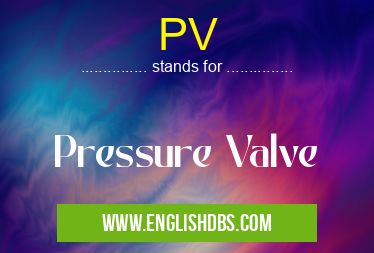What does PV mean in UNCLASSIFIED
PV stands for Pressure Valve. It is a type of valve used to regulate the flow of fluids, such as liquids or gases, by controlling the pressure within a system.

PV meaning in Unclassified in Miscellaneous
PV mostly used in an acronym Unclassified in Category Miscellaneous that means Pressure Valve
Shorthand: PV,
Full Form: Pressure Valve
For more information of "Pressure Valve", see the section below.
Types and Usage of PV
PVs come in various types and can be classified based on their design, function, and application. Some common types of PVs include:
- Safety Relief Valve (SRV): Designed to release excess pressure from a system when it exceeds a specified threshold, preventing damage to equipment or injury to personnel.
- Pressure Reducing Valve (PRV): Used to reduce the pressure of a fluid flowing through a system, maintaining a constant downstream pressure regardless of fluctuations in the upstream pressure.
- Pressure Regulating Valve (PRV): Similar to a PRV, but with a wider range of pressure adjustment and more precise control over the downstream pressure.
- Back Pressure Valve (BPV): Prevents the flow of fluid in one direction, allowing it to flow only in the opposite direction. This helps maintain backpressure in a system, ensuring proper operation of equipment.
Operation and Applications
PVs operate by utilizing a diaphragm, piston, or bellows to sense the pressure of the fluid. When the pressure exceeds or falls below the desired set point, the PV opens or closes to maintain the desired pressure level.
PVs have a wide range of applications in various industries, including:
- Process industries (chemical, petrochemical, pharmaceutical)
- Power generation and distribution
- HVAC systems
- Water treatment and distribution
- Automotive and transportation
Advantages and Disadvantages of PVs
Advantages:
- Precise pressure control
- Protection against overpressure or underpressure
- Improved system efficiency
- Reduced energy consumption
- Enhanced safety and reliability
Disadvantages:
- Maintenance and calibration required
- Can be costly to install and maintain
- Potential for leaks or failures
Essential Questions and Answers on Pressure Valve in "MISCELLANEOUS»UNFILED"
What is a pressure valve (PV)?
A pressure valve (PV) is a component of a fluid system that automatically regulates the pressure of the fluid within the system. It opens or closes to maintain a desired pressure range.
How does a pressure valve work?
A pressure valve uses a spring-loaded diaphragm or piston to sense pressure fluctuations. When the pressure exceeds the set point, the diaphragm or piston moves to open the valve, allowing fluid to flow out and reduce the pressure. When the pressure drops below the set point, the spring closes the valve, preventing further flow.
What are the different types of pressure valves?
There are various types of pressure valves, including:
- Pressure relief valves: Designed to protect systems from overpressure by releasing excess fluid.
- Pressure reducing valves: Reduce the pressure of incoming fluid to a lower, predetermined level.
- Back pressure valves: Maintain a constant downstream pressure, regardless of fluctuations in the upstream pressure.
- Check valves: Allow fluid to flow in one direction only, preventing backflow.
What materials are pressure valves made of?
Pressure valves are typically made of materials that can withstand the pressure, temperature, and corrosive properties of the fluid being handled. Common materials include stainless steel, brass, bronze, and plastic.
What factors should be considered when selecting a pressure valve?
When selecting a pressure valve, key factors to consider include:
- System pressure range
- Maximum flow rate
- Fluid compatibility
- Required valve function (relief, reducing, back pressure, or check)
- Environmental conditions
How are pressure valves maintained?
Regular maintenance of pressure valves is crucial to ensure proper functioning and prevent failures. Maintenance tasks typically involve cleaning, inspecting, and testing the valve to verify its accuracy and reliability.
Final Words: Pressure Valves (PVs) play a critical role in controlling fluid pressure within various systems. By selecting the appropriate type of PV and ensuring proper installation and maintenance, industries can achieve improved performance, efficiency, and safety in their operations.
PV also stands for: |
|
| All stands for PV |
